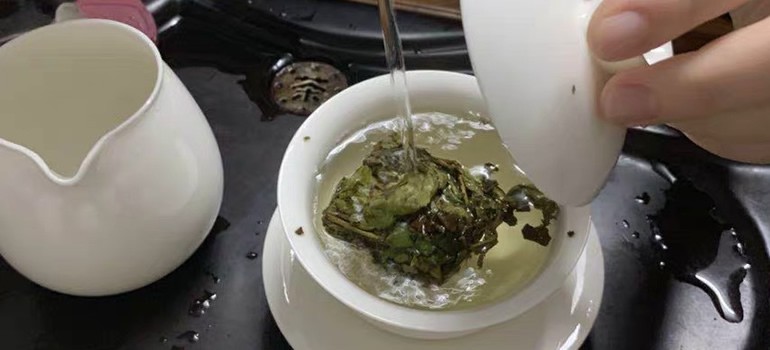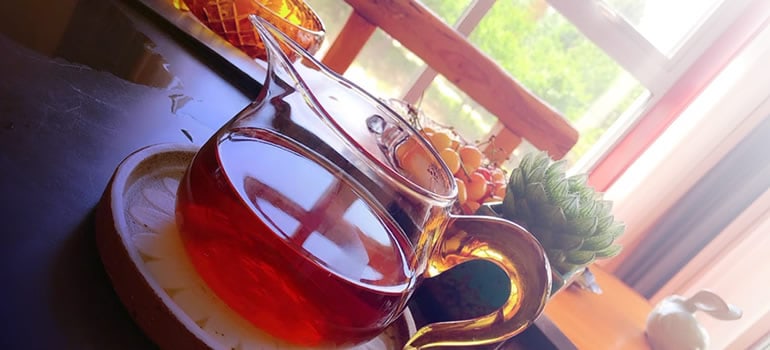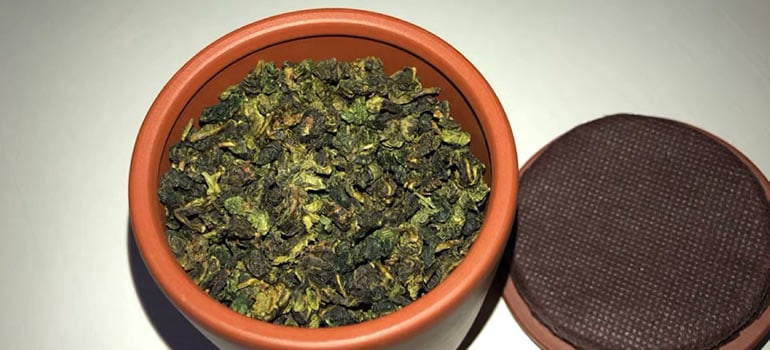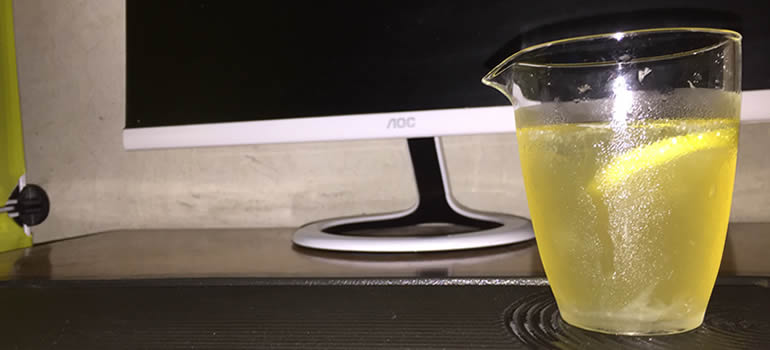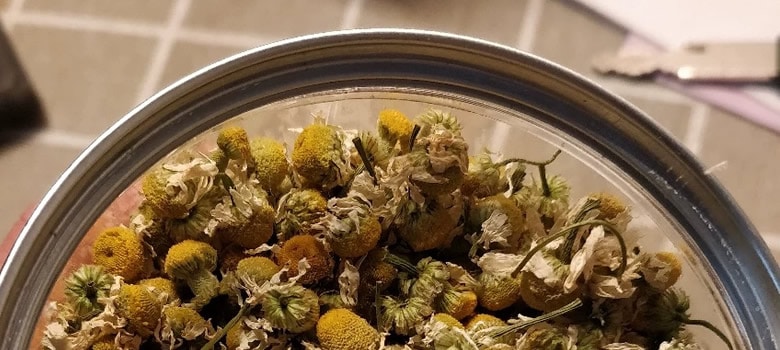
Chamomile is an herb that has been known for its various medicinal and health benefits for a long time now.
It is not a coincidence that this is one of the two varieties of tea that are a must-have in my home; it has proven its worthiness.
But drinking the same cup of regular chamomile tea every day may not seem like the best thing.
Sometimes we just need to change things up a bit. This is why I decided to create this extensive list with some useful tips and tricks that I have used throughout the years to make my cup of chamomile tea taste better.
The good news is that chamomile tea combines easily with different teas and ingredients. Or in other words, there will always be a way to change things up a bit. Let’s see.
11 Ways to Make Chamomile Tea Taste Better
1. Use High-Quality Chamomile Tea
I know it may seem obvious, but it needs to be mentioned, especially if you have only been drinking chamomile tea bags.
You never know how much you are missing until you try drinking loose whole flowers and leaves chamomile tea.
The real chamomile tea has a very full-bodied taste and a slight deep sweet after taste, almost as if there is a honey in it. A fantastic aroma also accompanies the great flavor.
I am sorry, but I have to say it, chamomile tea bags cannot even compare to it. Ever since I started drinking loose chamomile tea, I have never looked back.
No matter what I say, I cannot do it justice; it needs to be tried.
2. Use the Right Preparation Methods
To make the best tasting chamomile tea, you need to know what is the best way to prepare it.
- Use up to four grams (or up to two tablespoons) of loose chamomile tea per standard 8.5 oz cup of water;
- The recommended brewing temperature is about 212 degrees F.; and
- The recommended steeping time is about 3 to 5 minutes.
If you are using fresh chamomile flowers, you can use up to 3 or 4 tablespoons of them.
The generally accepted steeping time is between 3 to 5 minutes for chamomile tea bags.
However, lose chamomile tea can be steeped for a longer, typically about 10 minutes (and up to 60 minutes) or until the chamomile flowers start sinking to the bottom.
This allows the chamomile flowers to release all their flavors and compounds fully into the water, making the tea stronger, more full-bodied, and you will be able to take full advantage of its medicinal properties.
The good thing about chamomile tea is that, unlike black or green tea, longer steeping time does not make it taste bitter.
However, if you will be steeping your chamomile tea for longer, make sure to have it stored in a closed container so you can preserve the heat for longer.
3. Add Different Sweeteners
Different sweeteners can be used with chamomile tea to make it taste sweeter and more lively.
One of my personal favorites is honey. Good high-quality honey is a must. It complements the unique natural sweetness of chamomile tea. For the best results, you can try to use one or two teaspoons of honey, depending on how much of a sweet tooth you have.
What is better is that if you have a sore throat, chamomile and honey can soothe your throat; a definite recommendation.
There are other ways you can sweeten your tea. You can add sugar or sweeteners (sugar substitutes) like stevia, sucralose, aspartame, acesulfame potassium, and more.
In my opinion, these do not fare as well as honey does. Besides, both sugar and sweeteners have been associated with some adverse health effects.
It is recommended to avoid using sugar or artificial sweeteners as much as possible; nonetheless, they can be used to sweeten up one’s tea.
4. Mix It With Different Types of Tea
Chamomile tea can be effectively mixed with different types of tea due to its mild flavor.
Some teas that can be mixed with chamomile tea are:
- Spearmint tea;
- Blackberry tea;
- Lemongrass tea;
- lemon balm tea;
- Green tea;
- Linden tea;
- Rooibos tea;
- Rosebud tea;
- White tea (Silver needle);
- Lavender tea; and
- Hibiscus tea.
Hibiscus tea can add a pleasant fruity kick with slight astringent notes to your chamomile tea.
Lavender is another popular tea that is used for its calming effects. The unique flowery flavor combined with the slight earthy and smokey notes can complement the flavor of chamomile really well. The combination of these teas can make for the perfect late evening tea that can aid your sleep and help you unwind.
Chamomile tea can also be mixed with both spearmint and peppermint, although the former is usually better.
With that being said, the great thing is that you do not have to limit yourself to mixing just two types of tea.
Some great tasting examples are:
- Chamomile, rooibos, and hibiscus;
- Chamomile, linden, and hibiscus;
- Chamomile, rooibos, and lavender;
- Chamomile, lemongrass, and spearmint; and
- Chamomile, spearmint, and hibiscus;
You can actually combine two different types of tea with some of the other things mentioned in this article. For example:
- Chamomile, rosebuds, a little natural honey, and apples.
For more ideas, check out the next sections of this article, where I go over some of the best foods and condiments that can be used with chamomile tea to make it taste better.
5. Use Different Types of Condiments and Spices
Spices are another method that you can use to improve the taste of your chamomile tea. Spices are not reserved only for the Masala chai.
There is a wide variety of spices and condiments that you can use like:
6. Combine It With Different Types of Food
The first thing that comes to my mind is to add some fresh ripe fruits to your chamomile tea.
Fruit can actually be used to sweeten your tea somewhat (depending on what kind of fruit you use).
A few fruit recommendations that you can try to experiment with are:
- Blueberries;
- Apple slices;
- Mangoes;
- Lemons (or lemon peels);
- Pears;
- Passion fruit;
- Peach;
- Raspberries;
- Ginger;
- Oranges (or orange peels); and
- Strawberries.
Alternatively, and this may not be to the liking of some tea connoisseurs, you can add a little fruit juice. However, keep in mind that many fruit juices contain high amounts of sugar.
You can also add some organic milk or cream to your chamomile tea.
Milk will not make your cup of tea sweet like honey or sugar will. However, it will give your chamomile tea a very mild creamy flavor and consistency.
Milk and chamomile tea may do well for a late-night tea. Both milk and chamomile tea are considered to aid sleep, although these claims are not really science-backed – just make sure that you are not lactose intolerant.
7. Use Quality Teaware
Like it or not, the teaware you use does play a role in how good your tea tastes.
There are a few different types of teapots:
- Ceramic teapots – They are great at retaining heat and are very durable and sturdy. However, they are heavier;
- Porcelain teapots – Very lightweight but more easily breakable; and
- Glass teapots – Glass is almost a must-have for flowering teas and tea mixtures because it allows you to seem them in their full glory. However, glass does not retain heat, and it is more delicate.
You also need an infuser. A good quality stainless steel infuser is mandatory. It will allow you to easily steep your tea and infuse the water without ruining it with having floating tea parts in it.
The quality of the teacups is also important. There is a wide variety of teacups, like:
- Ceramic and porcelain teacups – Ceramic and porcelain retain heat well and does not alter the taste of your cup of tea.
- Glass tea cups – Glass is not good at retaining heat; it is heavy and can be easily broken. However, it keeps your tea taste unaltered.
- Metal teacups – Metal is not good at retaining heat, but it is extremely durable. If using metal cups, make sure to use only stainless-steel ones.
- Avoid aluminum as it can react with more acidic foods.
- Plastic teacup – Plastic is the worst material to drink your tea from. The heat (and acidic foods) from the tea can react with the plastic chemicals which will leach into your tea. Plastic is not good at keeping the taste of your tea fresh and natural.
8. Make a Tea Cocktail
Alcohol is another thing that you can add to your chamomile.
I like to call them “adult” teas. Let’s be honest. Alcohol can make a lot of things taste better. And so is the case with your cup of chamomile tea.
This is not going to be suitable for a morning tea, but it might go well as a late-night tea.
In the case of chamomile, the best alcohol that you can use is one that complements its floral flavor. For example:
- Gin; or
- Vodka
Of course, you can take things further and turn this into a full-fledged cocktail.
A chamomile gin cocktail is easy to make, all you need is some chamomile loose flowers or bags, some honey, gin, and lemon juice.
Another popular recipe is the Hot Toddy, which combines whiskey (or other alcohol) with lemon, honey, and chamomile tea.
Another great and refreshing recipe is the strawberry and chamomile Paloma. It is made with chamomile and honey syrup, grapefruit juice, strawberries, and tequila.
9. Make a Tea Mocktail
For a more morning-friendly option, you can always make yourself a mocktail.
Mocktails do not contain alcohol, and they are a great and refreshing way to start your day. They are quick and easy to prepare.
One of the simplest chamomile tea mocktails is the following:
- Start by preparing chamomile tea. You can either brew it the usual way or cold brew it;
- Cover and refrigerate the tea until it is properly chilled; then
- Fill a glass with ice, add chamomile tea, one teaspoon of honey, and top it off with sparkling water.
10. Make Chamomile Iced Tea
Who said that chamomile tea should only be consumed hot. Maybe during the winter, it should be, but when the temperatures start to rise in the summer, you can treat yourself with a nice and refreshing chamomile iced tea.
Iced tea is easy to make, and best of all, it is always made in large quantities. You can also add other ingredients to your iced chamomile tea.
An easy way to make some delicious chamomile tea is:
- Bring to a slight boil about 64 oz of water or about half of a gallon;
- Add about 12 chamomile tea bags;
- Add any other ingredients. For example, you can add lemon juice, lemon or orange rind, grated ginger, honey, and others. For more ideas make sure to check the other sections of this article;
- Pour the tea through a tea strainer into a pitcher; and
- Cover and refrigerate.
11. Make Yourself a Chocolate Chamomile Tea
Different tea blends contain small amounts of cocoa nibs in them.
And who doesn’t like chocolate?
Even if you cannot find a chocolate chamomile tea blend, you can always try to make one yourself.
Here is a simple and very yummy chocolate tea recipe:
- Use 1-1/2 cups of boiled milk;
- Add about one teaspoon of chamomile tea powder, 2 to 3 tablespoons of loose chamomile tea, or 1 to 2 chamomile tea bags;
- Add 1/2 teaspoon of cocoa powder, 2 teaspoons of sugar, and a pinch of cinnamon;
- Mix the different ingredients well and bring the mixture to a rolling boil;
- When it comes to a slight boil, your chocolate chamomile tea is ready. Pour the tea through a tea strainer, and you are good to go.
If you enjoy chocolate, you can also add little chocolate chips or shavings to your tea as well.
What Does Chamomile Tea Taste Like?
Chamomile tea has a very distinct earthy and nuttier taste. The aftertaste is especially interesting as it has a very distinct and unique sweetness that is almost reminiscent of heavy-bodied honey. Overall chamomile tea is very light-bodied, with a refreshing and palatable taste
However, chamomile tea can taste very differently depending on the quality of the chamomile and which parts of the plant are predominantly found in your tea bags or loose tea.
Can You Make Chamomile Tea Taste Better Without Sugar?
Absolutely. You can make chamomile tea taste better without adding sugar to it.
Many people advise on using fruits as a sugar-free alternative to making your tea taste better. However, fruits do contain sugar in them (usually in the form of fructose). So adding apple slices to your tea and then eating them is going to increase your sugar intake.
This is one of the many hidden sources of sugar in one’s diet!
For example, 100 grams of apple slices contain about 10 grams of sugar in it.
And don’t let the bitterness of citrus fruits trick you. They, too, contain sugar. One hundred grams of lemon slices have 2.5 grams of sugar, and 100 grams of orange contains about 9 grams of sugar.
Some people really like drinking their chamomile tea with cinnamon, or vanilla which is a sugar-free alternative. Others prefer to use natural sweeteners like licorice root and anise.
Of course, your personal tastes and preferences will have a say in this.
Some people just cannot stand the smell and taste of chamomile tea.
If you are one of these people and for some reason, you have to drink chamomile tea, then mixing it with other teas, foods, and spices is an excellent way to do it.
However, if you do not like the taste of chamomile tea, you do not really need to drink it.
Why Do so Many People Not Like the Taste of Chamomile Tea?
With tea, it is all down to personal taste and preference. It is completely normal for some people not to like the taste of chamomile tea, while others will adore it.
It may also be just an acquired taste.
But here’s the thing.
One of the problems I alluded to at the beginning of this article was about the actual quality of chamomile tea. The majority of bagged chamomile tea seems to be of poor quality.
This becomes very obvious when you compare side to side two cups of chamomile tea; one with bagged chamomile and the other with loose chamomile.
To be able to enjoy your chamomile tea, you need to use chamomile that has been picked fresh and dried correctly.
The bagged chamomile tea often tastes very bland and water-like. Some chamomile teas are even bitter. Which should never be the case
Low-quality tea is often just that – low quality. It can be made from the fannings or dust. Depending on the quality of the packaging, there can also be significant freshness issues too.
All this makes the low-quality tea just overall unpleasant, which does not do justice to this amazing herb, because a lot of people are immediately turned away from it.
P.S.
I have categorized the different ways to make chamomile tea taste better in 11 categories
However, the top ranking article for this search query is this one.
It is very short and says that they give you 23 tips. They are just randomly throwing out some ideas and to me it seems like a clickbaity title but maybe it works.
Anyways, what I am trying to say is that if you decide to do something similar, I thought it would be helpful to give you the total number of different tips and ideas I have given in this article, which is between 50 to 55.

